Subjects:
- Preface
- Controlling the actuators
Preface:
An actuator is an object that contains electronic components and, when voltage and current are applied through an ECU, takes action. This can range from adjusting a mechanical position to regulating a certain function within a vehicle or other controlled system. Every modern vehicle contains dozens of actuators in the engine compartment, the exterior and the interior.
The ECU determines how the actuator should be controlled based on the sensor data and the program. Example: when the mixture of a petrol engine is too lean, the lambda sensor (sensor) measures an excess of oxygen. The ECU controls the injector (actuator) for a longer period of time until the signal from the lambda sensor has reached its desired value. The ECU therefore has a regulating function. See also the page: process control.
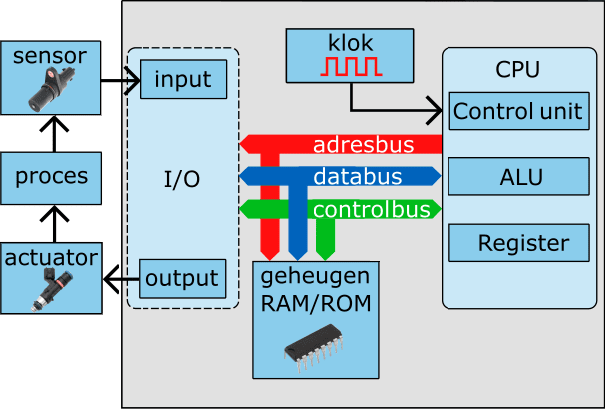
Controlling the actuators:
The ECU sends a current through the actuator by switching on a positive, or in most cases, the ground. The actuators translate electronic signals from the ECU into physical movements or actions. Actuators often contain a coil or electric motor that can be used to execute a command. We also find actuators as an electric motor (stepper motor), as a heating element or as lighting.
Actuators with a coil:
- Activated carbon filter valve
- Coils
- Common rail pressure regulator
- Alternator rotor
- Injector
- Magnetic clutch air conditioning compressor
- camshaft adjuster
- PWM controlled fuel delivery pump
- Relay
- Wastegate or VGT adjuster
Example: the image below shows a relay circuit. The ECU switches the control current of the relay on or off. The moment pin 85 is switched to ground by the ECU, current flows through the relay coil and it becomes magnetic. As a result of the magnetic field, the main current switch is closed.
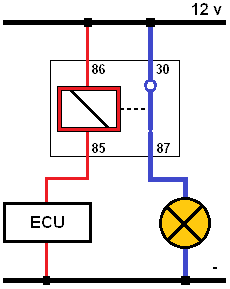
Actuators with electric motor:
- Power door locks
- Electric throttle or idle control valve
- Electrically adjustable seats and mirrors
- Heater valves in the heater house, automatic air conditioning
- Headlight adjustment motor
- Radiator fan
- Windshield wipers
- Sliding tilt roof
Example: the image below shows the schematic of the electric mirror adjustment. One adjustment motor is for the vertical adjustment and the other for the horizontal. The polarity determines the direction of rotation of the electric motors, and therefore to which side the mirror glass is tilted. The ECU uses the input signals to determine how the actuating motors are controlled. This can be: on the basis of the switch that the driver operates, the memory function, or when operating reverse gear.
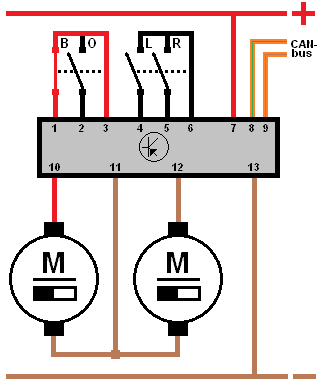
Actuators as heating element:
- Rear window heating
- Battery pack depletion
- Fuel filter heater
- Auxiliary heating for interior ventilation
- Mirror glass heating
- Seat heating
- Steering wheel heating
Example: when an actuator has a heating function, the temperature is limited by a PTC. In this example we see a auxiliary heating element in which glow coils ensure the heating of the incoming interior air. The ECU applies pulsating voltages to one or more glow coils to bring the component up to temperature as quickly as possible and to keep it at the desired temperature with a reduced current.
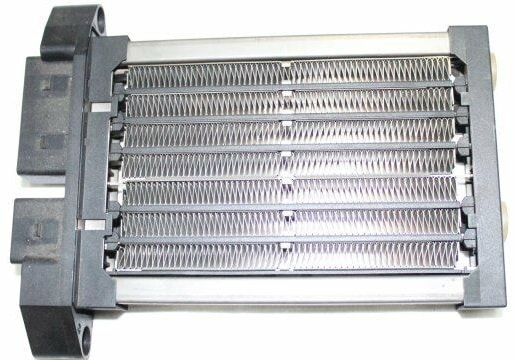
Actuator for lighting functions:
- Dashboard (control) lights
- Lighting in headlight and rear light units
Example: to limit the power of lighting, or to give a lamp multiple functions, light bulbs and LEDs, are controlled by the ECU. In the image below we see a light that is connected by a duty cycle is being directed. The pulse width determines how brightly the lamp lights up. The lamp can now function as a rear light (25%) or as a brake light (90%).
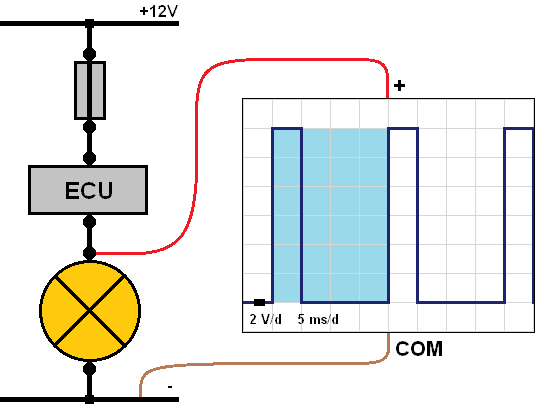
Related page:
